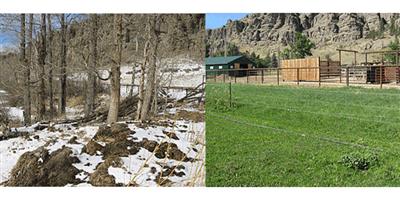Stillwater County, Montana, residents enjoy some of the finest water resources in the country, but there still remain avenues for improvement. The local Natural Resources Conservation Service (NRCS) office in Columbus has made water quality a priority for more than 10 years and has focused on the agricultural waste generated in corrals and feedlots.
According to Ted Nelson, NRCS district conservationist in Columbus, early settlers routinely placed their corrals near a stream for obvious reasons—water was available, the site was often sheltered by trees, and it was convenient for the operator since it was typically near the house. “Today, we know that is not the optimal setting, and we now have the tools to make improvements that result in a facility that not only improves water quality but also handling efficiency and animal health,” Nelson said.
The premise is simple – keep agricultural waste from directly entering the stream. This means that the waste is contained or filtered and that clean water from rooftops or from up gradient is not allowed to flow through the facility. The Montana Department of Environmental Quality has rules in place that define confined feeding facilities by size. Operators with less than 300 cattle (or the equivalent of other species) can utilize vegetative filters to treat the waste while larger facilities typically have to construct impoundments to contain the waste runoff. The great majority of corrals in Stillwater County fall into the small category.
Nelson said NRCS always strives to apply modifications to the original corral but space and topography limitations sometimes dictate the move to a new site. The basic practices include moving the corral perimeter away from the stream and shaping the lot so water flows evenly through a vegetated filter area that traps solids and will utilize nutrients during the growing season. Roof runoff structures take clean water from this source away from the lot. An earthen berm may be necessary to divert clean upland water away from the lot. Stockwater and shelter are provided as needed as are access roads, stream crossings, and animal walkways. A plan is developed to clean the facility and spread the manure appropriately. The design of the corral interior is left to the producer to determine.
Tom and Katie Eaton saw the need to address their corral and asked NRCS to help with the process. Their facility was next to the Stillwater River with a water gap to the river providing a watering source but it also provided a direct route for waste to enter the river. A new corral was constructed away from the river with a vegetated treatment area filtering any dirty water runoff. Tom and Katie took the opportunity to configure the new corral to more efficiently handle cattle.
NRCS has collaborated with 40 producers in recent years to improve their corral or feedlot facilities with more than 20 of them being in the Stillwater River drainage.
CLICK HERE to read more Montana NRCS success stories
Source: Montana NRCS




